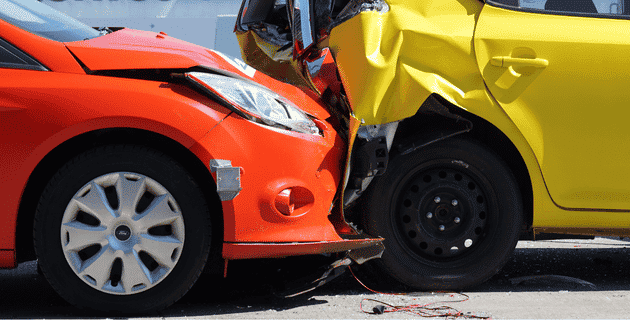The open road, the sunshine, and vacation time—it seems that summer is meant for road trips. With so many of your fellow travelers on the road, though, there’s a chance for collisions. That’s especially true if you’re on a long drive, on unfamiliar roads or distracted by confusing signs, or even the passengers in your car.
So, how do you avoid a vacation-spoiling accident? Knowing the most common summer collisions – and their causes – can help you take action to avoid them. Here’s what you need to know.
Rear-end Collisions
These common types of collision can be caused by tailgating or distracted driving during stop-and-go traffic. Rear-end collisions also happen when motorists drive too fast or aggressively. To avoid a rear-end collision:
-
- Slow down and watch your speed.
- Increase your following distance between your vehicle and the car in front.
- Avoid stopping suddenly or swerving.
- Make sure your taillights and turn signals are working.
Pro Tip: If your car has one, an automatic braking system or forward collision warning system can help prevent these types of accidents.
Front-end Collisions
When the front end of your vehicle strikes another vehicle, tree, telephone pole, or other object, it’s a front-impact collision. These types of crashes are common during rainy weather. To avoid a front-end collision:
-
- Drive more slowly in the rain. Roads are slippery. Fog can impair your vision. Give yourself time to adjust.
- Increase your following distance in inclement weather. This will help give you more time to react.
- Avoid distractions; even playing with the radio or talking to passengers can divert your attention.
- Lane keeping systems can help. They alert you when you’re drifting out of lane, and can even steer your car back into the lane.
Side-impact Collisions
You know these as T-bone collisions or sideswipes. They often occur at intersections, as a result of confusion about which vehicle has the right of way. However, they also can occur if you run a red light or change lanes without warning. To avoid a side-impact collision:
-
- Look both ways as you approach a stoplight. Slow down when you see yellow; don’t speed up. You could risk running a red light.
- Come to a complete stop at every stop sign. Know where other traffic is before proceeding.
- Check your blind spot before changing lanes.
- When passing cars, be alert for other drivers changing lanes unexpectedly.
Highway Construction Collisions
Construction crews are out on the roadways, often sharing space with vehicles traveling at high speeds. That’s why it’s especially important to watch for signage and adjust your speed as you navigate past a construction site. To avoid a highway construction collision:
-
- Pay attention to construction site speed limits and follow them.
- Watch for signage and personnel directing you where to go.
- Slow down as you are passing workers and be alert.
- Increase your following distance for the car in front of you.
Interstate Collisions
High speeds coupled with distracted, aggressive, or drowsy drivers can cause accidents. When a crash happens on the highway, it can sometimes have a chain reaction effect. Make sure to use due diligence when you’re traveling at high speed around other vehicles. To avoid an interstate collision:
-
- Follow the speed limit and maintain a safe following distance from other drivers.
- Clearly indicate with your turn signal when you wish to change lanes. Check your blind spot before doing so, and make sure cars in other lanes aren’t heading to the same place you are.
- Maintain your distance from cars that are driving aggressively or dangerously.
- Limit distractions. Your priority is to drive safely.
Parking Lot Collisions
We may not think about it, but parking lots can be dangerous. When the lot gets busy, it’s easy to have multiple cars moving in different directions. Inattention or simply a bad decision can cause a collision. To avoid a parking lot collision:
-
- If possible, park in a spot away from other cars.
- Check your surroundings before getting into your car to pull out of your parking space.
- Don’t rely on technology alone (such as rearview cameras). The image can be distorted by sunlight or shadows. Use your mirrors.
- Move slowly and be aware of pedestrians and cars in the immediate area.
General Tips for Safe Summer Driving
- Don’t drive when you’re drowsy. If you’re feeling tired or having a hard time staying awake, pull over in a safe place and take a power nap.
- Don’t use your cell phone when driving except for emergencies.
- Don’t eat or drink anything in spillable containers while you’re driving.
- Don’t drive when you’ve had a few drinks. Use a designated driver or call a ride-share service instead.
- Avoid driving during high traffic times.
- Take your car in for a maintenance checkup before you go on a road trip. This will help avoid equipment-related accidents.
Finally, make sure your car is insured so you are fully covered in case of an accident.
Safe travels!
This article is furnished by California Casualty, providing auto and home insurance to educators, law enforcement officers, firefighters, and nurses. Get a quote at 1.866.704.8614 or www.calcas.com.
- Graduation – When to Remove Your Child from Your Auto Policy - May 18, 2023
- How to Prevent Catalytic Converter Theft - May 17, 2023
- How Much Does Home Insurance Cost? - May 17, 2023

